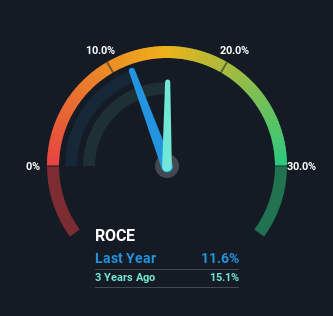Electronic Arts (NASDAQ:EA) Is Reinvesting At Lower Rates Of Return
Did you know there are some financial metrics that can provide clues of a potential multi-bagger? Ideally, a business will show two trends; firstly a growing return on capital employed (ROCE) and secondly, an increasing amount of capital employed. Ultimately, this demonstrates that it's a business that is reinvesting profits at increasing rates of return. However, after briefly looking over the numbers, we don't think Electronic Arts (NASDAQ:EA) has the makings of a multi-bagger going forward, but let's have a look at why that may be.
Return On Capital Employed (ROCE): What is it?
If you haven't worked with ROCE before, it measures the 'return' (pre-tax profit) a company generates from capital employed in its business. Analysts use this formula to calculate it for Electronic Arts:
Return on Capital Employed = Earnings Before Interest and Tax (EBIT) ÷ (Total Assets - Current Liabilities)
0.12 = US$1.2b ÷ (US$14b - US$3.5b) (Based on the trailing twelve months to March 2022).
Therefore, Electronic Arts has an ROCE of 12%. On its own, that's a standard return, however it's much better than the 6.9% generated by the Entertainment industry.
See our latest analysis for Electronic Arts
Above you can see how the current ROCE for Electronic Arts compares to its prior returns on capital, but there's only so much you can tell from the past. If you'd like to see what analysts are forecasting going forward, you should check out our free report for Electronic Arts.
So How Is Electronic Arts' ROCE Trending?
When we looked at the ROCE trend at Electronic Arts, we didn't gain much confidence. Over the last five years, returns on capital have decreased to 12% from 23% five years ago. However, given capital employed and revenue have both increased it appears that the business is currently pursuing growth, at the consequence of short term returns. And if the increased capital generates additional returns, the business, and thus shareholders, will benefit in the long run.
Our Take On Electronic Arts' ROCE
In summary, despite lower returns in the short term, we're encouraged to see that Electronic Arts is reinvesting for growth and has higher sales as a result. In light of this, the stock has only gained 16% over the last five years. So this stock may still be an appealing investment opportunity, if other fundamentals prove to be sound.
While Electronic Arts doesn't shine too bright in this respect, it's still worth seeing if the company is trading at attractive prices. You can find that out with our FREE intrinsic value estimation on our platform.
For those who like to invest in solid companies, check out this free list of companies with solid balance sheets and high returns on equity.
Have feedback on this article? Concerned about the content? Get in touch with us directly. Alternatively, email editorial-team (at) simplywallst.com.
This article by Simply Wall St is general in nature. We provide commentary based on historical data and analyst forecasts only using an unbiased methodology and our articles are not intended to be financial advice. It does not constitute a recommendation to buy or sell any stock, and does not take account of your objectives, or your financial situation. We aim to bring you long-term focused analysis driven by fundamental data. Note that our analysis may not factor in the latest price-sensitive company announcements or qualitative material. Simply Wall St has no position in any stocks mentioned.

 Yahoo Finance
Yahoo Finance 
